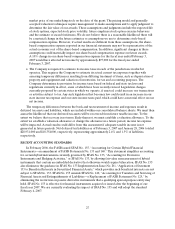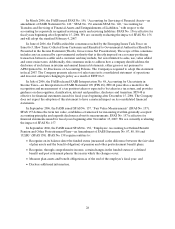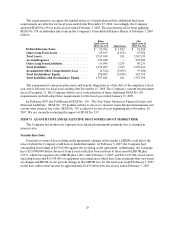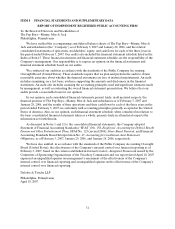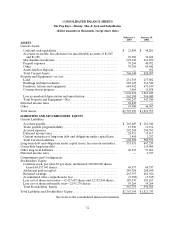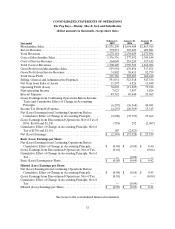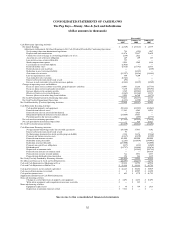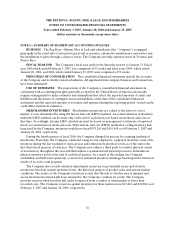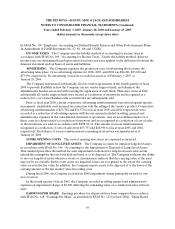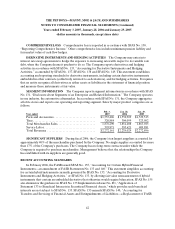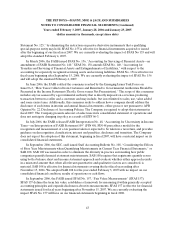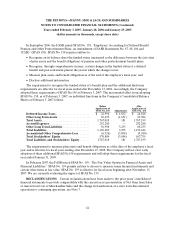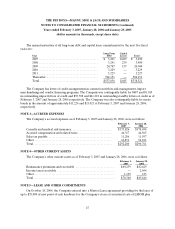Pep Boys 2006 Annual Report Download - page 76
Download and view the complete annual report
Please find page 76 of the 2006 Pep Boys annual report below. You can navigate through the pages in the report by either clicking on the pages listed below, or by using the keyword search tool below to find specific information within the annual report.THE PEP BOYS—MANNY, MOE & JACK AND SUBSIDIARIES
NOTES TO CONSOLIDATED FINANCIAL STATEMENTS (Continued)
Years ended February 3, 2007, January 28, 2006 and January 29, 2005
(dollar amounts in thousands, except share data)
37
CASH AND CASH EQUIVALENTS Cash equivalents include all short-term, highly liquid
investments with a maturity of three months or less when purchased. All credit and debit card transactions
that process in less than seven days are also classified as cash and cash equivalents.
PROPERTY AND EQUIPMENT Property and equipment are recorded at cost. Depreciation and
amortization are computed using the straight-line method over the following estimated useful lives:
building and improvements, 5 to 40 years, and furniture, fixtures and equipment, 3 to 10 years.
Maintenance and repairs are charged to expense as incurred. Upon retirement or sale, the cost and
accumulated depreciation are eliminated and the gain or loss, if any, is included in the determination of
net income. The Company reviews long-lived assets for impairment whenever events or changes in
circumstances indicate that the carrying amount of an asset may not be fully recoverable.
SOFTWARE CAPITALIZATION The Company, in accordance with AICPA Statement of
Position 98-1, “Accounting for the Costs of Computer Software Developed or Obtained for Internal Use”,
capitalizes certain direct development costs associated with internal-use software, including external direct
costs of material and services, and payroll costs for employees devoting time to the software projects.
These costs are amortized over a period not to exceed five years beginning when the asset is substantially
ready for use. Costs incurred during the preliminary project stage, as well as maintenance and training
costs, are expensed as incurred.
CAPITALIZED INTEREST Interest on borrowed funds is capitalized in connection with the
construction of certain long-term assets. Capitalized interest was immaterial in fiscal years 2006, 2005 and
2004.
REVENUE RECOGNITION The Company recognizes revenue from the sale of merchandise at the
time the merchandise is sold. Service revenues are recognized upon completion of the service. The
Company records revenue net of an allowance for estimated future returns. The Company establishes
reserves for sales returns and allowances based on current sales levels and historical return rates. Return
activity is immaterial to revenue and results of operations in all periods presented.
ACCOUNTS RECEIVABLE Accounts receivable are primarily comprised of amounts due from
commercial customers. The Company records an allowance for doubtful accounts based on percentage of
sales. The allowance is revised on a monthly basis against historical data for adequacy. Specific accounts
are written off against the allowance when management determines the account is uncollectible.
TRADE PAYABLE PROGRAM LIABILITY In the third quarter of fiscal 2004, the Company
entered into a vendor financing program with an availability of $20,000. Under this program, the
Company’s factor makes accelerated and discounted payments to its vendors and the Company, in turn,
makes its regularly-scheduled full vendor payments to the factor. There were outstanding balances of
$13,990 and $11,156 under the program at February 3, 2007 and January 28, 2006, respectively.
VENDOR SUPPORT FUNDS The Company receives various incentives in the form of discounts and
allowances from its vendors based on the volume of purchases or for services that the Company provides to
the vendors. These incentives received from vendors include rebates, allowances and promotional funds.
Typically, these funds are dependent on purchase volumes and advertising activities. The amounts received
are subject to changes in market conditions, vendor marketing strategies and changes in the profitability or
sell-through of the related merchandise for the Company.


